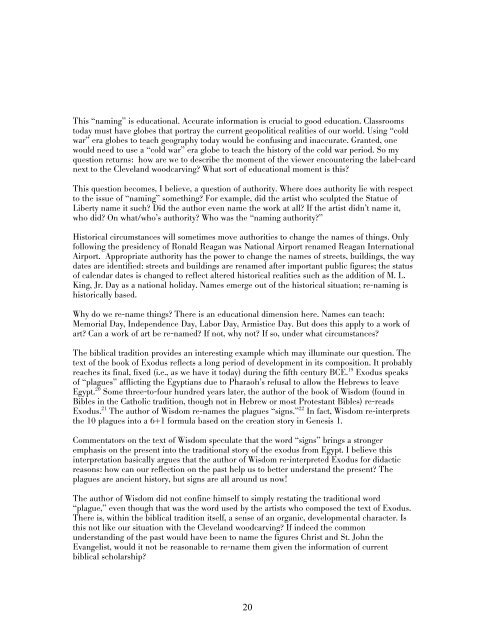SECTION 1 - via - School of Visual Arts
SECTION 1 - via - School of Visual Arts
SECTION 1 - via - School of Visual Arts
You also want an ePaper? Increase the reach of your titles
YUMPU automatically turns print PDFs into web optimized ePapers that Google loves.
This “naming” is educational. Accurate information is crucial to good education. Classrooms<br />
today must have globes that portray the current geopolitical realities <strong>of</strong> our world. Using “cold<br />
war” era globes to teach geography today would be confusing and inaccurate. Granted, one<br />
would need to use a “cold war” era globe to teach the history <strong>of</strong> the cold war period. So my<br />
question returns: how are we to describe the moment <strong>of</strong> the viewer encountering the label-card<br />
next to the Cleveland woodcarving? What sort <strong>of</strong> educational moment is this?<br />
This question becomes, I believe, a question <strong>of</strong> authority. Where does authority lie with respect<br />
to the issue <strong>of</strong> “naming” something? For example, did the artist who sculpted the Statue <strong>of</strong><br />
Liberty name it such? Did the author even name the work at all? If the artist didn’t name it,<br />
who did? On what/who’s authority? Who was the “naming authority?”<br />
Historical circumstances will sometimes move authorities to change the names <strong>of</strong> things. Only<br />
following the presidency <strong>of</strong> Ronald Reagan was National Airport renamed Reagan International<br />
Airport. Appropriate authority has the power to change the names <strong>of</strong> streets, buildings, the way<br />
dates are identified: streets and buildings are renamed after important public figures; the status<br />
<strong>of</strong> calendar dates is changed to reflect altered historical realities such as the addition <strong>of</strong> M. L.<br />
King, Jr. Day as a national holiday. Names emerge out <strong>of</strong> the historical situation; re-naming is<br />
historically based.<br />
Why do we re-name things? There is an educational dimension here. Names can teach:<br />
Memorial Day, Independence Day, Labor Day, Armistice Day. But does this apply to a work <strong>of</strong><br />
art? Can a work <strong>of</strong> art be re-named? If not, why not? If so, under what circumstances?<br />
The biblical tradition provides an interesting example which may illuminate our question. The<br />
text <strong>of</strong> the book <strong>of</strong> Exodus reflects a long period <strong>of</strong> development in its composition. It probably<br />
reaches its final, fixed (i.e., as we have it today) during the fifth century BCE. 19 Exodus speaks<br />
<strong>of</strong> “plagues” afflicting the Egyptians due to Pharaoh’s refusal to allow the Hebrews to leave<br />
Egypt. 20 Some three-to-four hundred years later, the author <strong>of</strong> the book <strong>of</strong> Wisdom (found in<br />
Bibles in the Catholic tradition, though not in Hebrew or most Protestant Bibles) re-reads<br />
Exodus. 21 The author <strong>of</strong> Wisdom re-names the plagues “signs.” 22 In fact, Wisdom re-interprets<br />
the 10 plagues into a 6+1 formula based on the creation story in Genesis 1.<br />
Commentators on the text <strong>of</strong> Wisdom speculate that the word “signs” brings a stronger<br />
emphasis on the present into the traditional story <strong>of</strong> the exodus from Egypt. I believe this<br />
interpretation basically argues that the author <strong>of</strong> Wisdom re-interpreted Exodus for didactic<br />
reasons: how can our reflection on the past help us to better understand the present? The<br />
plagues are ancient history, but signs are all around us now!<br />
The author <strong>of</strong> Wisdom did not confine himself to simply restating the traditional word<br />
“plague,” even though that was the word used by the artists who composed the text <strong>of</strong> Exodus.<br />
There is, within the biblical tradition itself, a sense <strong>of</strong> an organic, developmental character. Is<br />
this not like our situation with the Cleveland woodcarving? If indeed the common<br />
understanding <strong>of</strong> the past would have been to name the figures Christ and St. John the<br />
Evangelist, would it not be reasonable to re-name them given the information <strong>of</strong> current<br />
biblical scholarship?<br />
20








